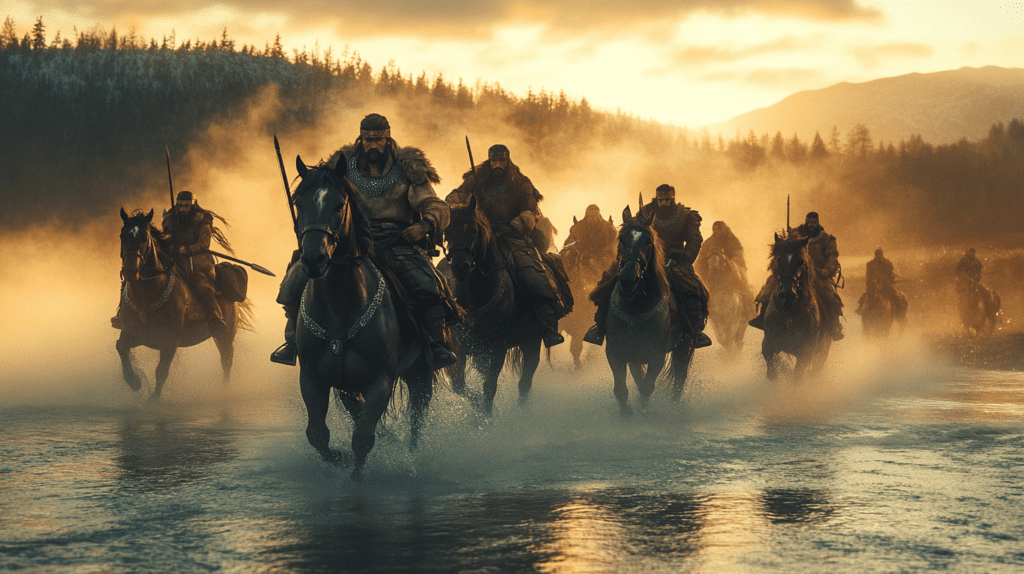
The Huns, a nomadic group originating from Central Asia, are best known for their dramatic and impactful invasions of Europe during the 4th and 5th centuries AD. Their arrival marked a significant turning point in European history, contributing to the eventual fall of the Western Roman Empire.
The Early Invasions
The Huns first appeared on the European scene around 370 AD, crossing the Volga River and swiftly conquering the Alans and the Goths. Their sudden and ferocious attacks caused a domino effect, pushing various Germanic tribes into Roman territories, which in turn led to increased pressure on the Roman Empire.

Attila the Hun
The most famous of the Hunnic leaders was Attila, who ruled from 434 until his death in 453. Under his leadership, the Huns became a formidable force. Attila’s campaigns were marked by their brutality and effectiveness. In 451, he invaded Gaul (modern-day France), where he faced a coalition of Romans and Visigoths at the Battle of the Catalaunian Plains. In the year 451 AD, the rolling plains of northeastern Gaul became the stage for one of history’s most dramatic and pivotal clashes: the Battle of the Catalaunian Plains. This epic confrontation saw the formidable Hunnic Empire, led by the fearsome Attila, face off against a coalition of Roman and Visigothic forces under the command of the seasoned Roman general Flavius Aetius and the Visigothic king Theodoric I.

As the sun rose on June 20, the air was thick with tension and the scent of impending battle. Attila, known as the “Scourge of God,” had swept across Europe, leaving a trail of devastation in his wake. His army, a fearsome mix of Huns and Germanic tribes, was poised to strike a decisive blow against the Western Roman Empire.
The Roman and Visigothic alliance, though diverse and often fractious, stood united against a common enemy. Theodoric I, a towering figure among the Visigoths, fought alongside Aetius, whose strategic genius had earned him the respect of both Romans and barbarians alike. The battle raged with unparalleled ferocity. Attila’s warriors, renowned for their speed and brutality, launched wave after wave of assaults. Yet, the Roman and Visigothic lines held firm. Theodoric I fought valiantly but fell in the heat of battle, his death a rallying cry for his warriors who fought with renewed fury.

As the day wore on, the tide began to turn. The disciplined Roman legions and the fierce Visigothic warriors gradually gained the upper hand. Attila, realizing the battle was slipping from his grasp, ordered a retreat. The Huns, though bloodied and battered, managed to withdraw, their ambitions of further conquest in Gaul thwarted. This was to be Attila’s first and only defeat.
The Battle of the Catalaunian Plains was a pyrrhic victory for the Romans and Visigoths. While they had halted Attila’s advance, the cost was immense. The battlefield was strewn with the bodies of thousands of fallen warriors, a grim testament to the battle’s brutality. Yet, this victory marked a crucial turning point, preserving the Western Roman Empire for a few more years and curbing the Hunnic threat.

Invasion of Italy
The following year, 452AD, Attila turned his attention to Italy, leading his forces on a significant and destructive invasion. The Huns sacked several key cities, including Aquileia, Patavium (modern Padua), Verona, Brixia (Brescia), Bergomum (Bergamo), and Mediolanum (Milan). The Roman general Aetius, who had previously faced Attila at the Battle of the Catalaunian Plains, was unable to stop the Huns’ advance a second time. However, the invasion was ultimately halted not by military force.
Attila was met by a delegation led by Pope Leo I near Mantua. The exact details of their conversation remain a mystery, but the outcome was remarkable: Attila agreed to withdraw his forces and spare Rome from direct attack. Several factors might have influenced Attila’s decision to withdraw from Italy. Some accounts suggest that Pope Leo’s presence and persuasive skills played a crucial role. However, the Huns were facing logistical challenges, including famine and disease which were prevalent in Italy at the time, which made further campaigning difficult.

The Decline
After Attila’s death in 453, the Hunnic Empire quickly began to disintegrate. Internal strife and the loss at the Battle of Nedao in 454 weakened their hold over the conquered territories. By 469, the Huns had largely disappeared from the European political landscape, though their legacy lived on in the turmoil they left behind. They accelerated the migration of various tribes into Roman territories, contributing to the fragmentation and eventual collapse of the Western Roman Empire. Their reputation for ferocity and their role in reshaping the European map have made them a subject of fascination and study for historians.




